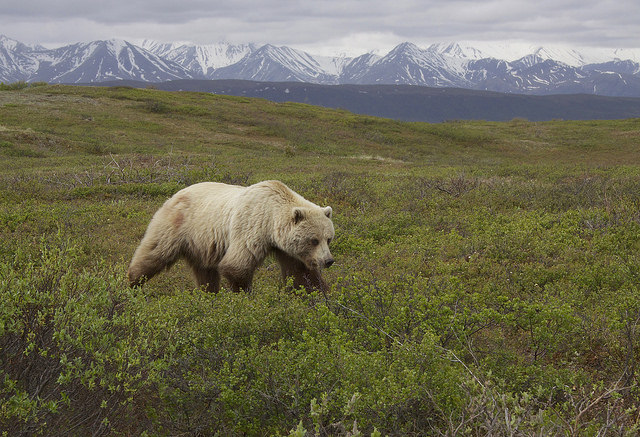It's hot out there for a bear
| 25 Jul 2015Foraging for food takes precedence over staying cool
Grizzly bears have a dilemma. They only have about seven months a year to eat 12 months’ worth of food, since they hibernate for the remaining five months. This imperative to eat is at odds with high temperatures during the best feeding months. Bears don’t have sweat glands, yet they must develop thick under-fur and a layer of fat for the winter. Do the bears reduce their activity to beat the heat, or do they stick to their eating mission?
Wildlife researchers followed small groups of grizzlies in British Columbia and recorded their activities. Previous research found that other types of bears reduce their activity levels when temperatures reached 20 °C. The researchers anticipated that grizzly bears would either be more active for longer periods during the summer while foraging for berries (the major high-energy food in the ecosystem they studied), or they would become more nocturnal and less active when it’s hot (since it is challenging for bears to dissipate their body heat).

Grizzly bear in Denali, Alaska. Image by Gregory “Slobirdr” Smith / CC BY-SA 2.0
Bears that had been fitted with GPS collars were tracked in a low-elevation area of the Coast Mountain Range that is steep and dry, with little shade but an abundance of berries. While the bears were tracked across all seasons, the main period of interest was roughly from July to October (berry season). The researchers also looked at day length, time of day, temperature, and duration of activity as they analyzed the bears’ behaviors.
When bears emerged from hibernation, their activity levels were initially low but then increased, remaining high from about July to September, then decreasing. Female bears also appeared to be more active than males. Different day lengths throughout the year didn’t influence activity levels, but active bouts for bears were longer in berry season. As it turns out, bears were less active at night, but were active for 78% of the time between sunrise and sunset. The bears also did not change their activity levels even when foraging in temperatures up to 40 °C.
The first hypothesis, that bears are more active for longer in summer, was thus supported, and bears did not reduce activity according to the heat dissipation limit theory. This is somewhat surprising, given that other bears and large tropical mammals are known to decrease their activity when temperatures rise. When sufficient food rewards are available, it seems, foraging takes precedence over heat.
These results may be specific to this ecosystem, where berries are the main source of energy for bears. They also underscore the importance of daylight and vision for bear foraging. It takes a long time to fill up on berries, so bears needs to stay active when berries are ripe and visible. In other ecosystems, bears display activity patterns that do not differ across seasons like those of the British Columbia bears, probably due to different day lengths at other latitudes and the availability of different foods. Because bears are successful across diverse climates, this shows they can change their habits to accommodate conditions. Further study could have implications for conservation of these animals in the wake of climate change.
Citation:
McLellan, M. L., & McLellan, B. N. (2015). Effect of season and high ambient temperature on activity levels and patterns of grizzly bears (Ursus arctos). PLOS One, 10(2), e0117734. DOI: 10.1371/journal.pone.0117734
